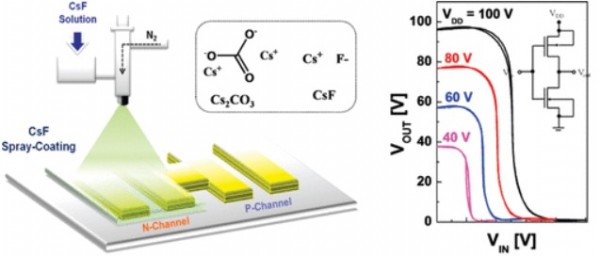Charge Injection Engineering of Ambipolar Field-Effect Transistors for High-Performance Organic Complementary Circuits
- 저자
- Kang-Jun Baeg, Juhwan Kim, Dongyoon Khim, Mario Caironi, Dong-Yu Kim, In-Kyu You, Jordan R. Quinn, Antonio Facchetti*, and Yong-Young Noh*
- 저널명
- ACS Applied Materials & Interfaces, 3, 8, 3205-3214 (2011)
- 년도
- 2011
- Link
- http://dx.doi.org/10.1021/am200705j 469회 연결
[Abstract]
Ambipolar π-conjugated polymers may provide inexpensive large-area manufacturing of complementary integrated circuits (CICs) without requiring micro-patterning of the individual p- and n-channel semiconductors. However, current-generation ambipolar semiconductor-based CICs suffer from higher static power consumption, low operation frequencies, and degraded noise margins compared to complementary logics based on unipolar p- and n-channel organic field-effect transistors (OFETs). Here, we demonstrate a simple methodology to control charge injection and transport in ambipolar OFETs via engineering of the electrical contacts. Solution-processed caesium (Cs) salts, as electron-injection and hole-blocking layers at the interface between semiconductors and charge injection electrodes, significantly decrease the gold (Au) work function (∼4.1 eV) compared to that of a pristine Au electrode (∼4.7 eV). By controlling the electrode surface chemistry, excellent p-channel (hole mobility ∼0.1–0.6 cm2/(Vs)) and n-channel (electron mobility ∼0.1–0.3 cm2/(Vs)) OFET characteristics with the same semiconductor are demonstrated. Most importantly, in these OFETs the counterpart charge carrier currents are highly suppressed for depletion mode operation (Ioff < 70 nA when Ion > 0.1–0.2 mA). Thus, high-performance, truly complementary inverters (high gain >50 and high noise margin >75% of ideal value) and ring oscillators (oscillation frequency ∼12 kHz) based on a solution-processed ambipolar polymer are demonstrated.
